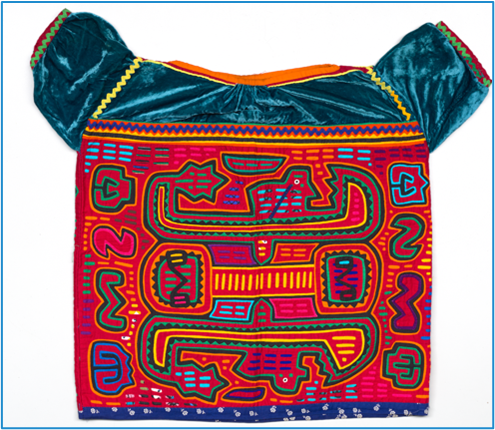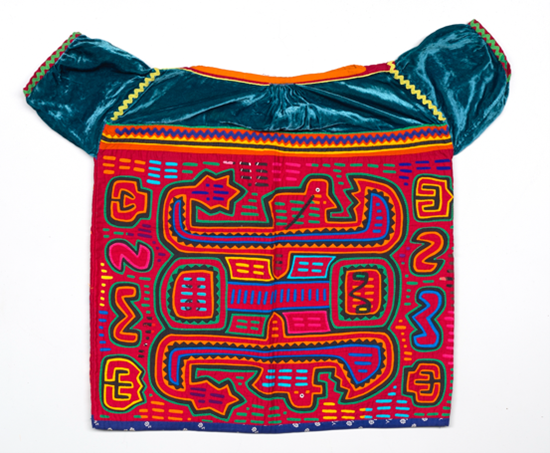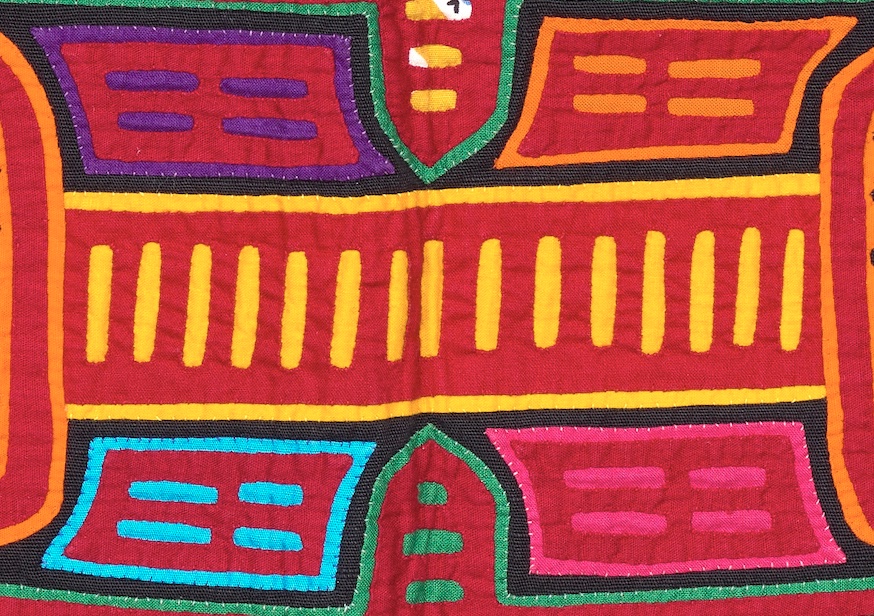The Guna people live in an autonomous region of coastal Panama. The mola—a blouse with appliqué panels on the front and back—is one of the most recognizable Guna art forms. Guna women devote hours daily to making molas together while they converse about their craft. This social context of production reinforces a shared set of aesthetic principles, including symmetry, contrast, and evenly distributed detail.[1] Well-made molas are admired and copied by others.
This brightly colored mola features birdlike figures rowing boats. Velvety sleeves and rick-rack trim elevate the sumptuous detail of the appliqué panels. There are many ways—cultural, historical, and economic—to approach these intricate works. For now, let’s look closer at this mola to understand its key aesthetic attributes.


1953-1975
Guna people
Dallas Museum of Art, The Isaac V. and Alicia C. Perez Mola Collection,
gift of The Kaleta A. Doolin Foundation, 2020.47.52
Symmetry: Imagine drawing a line from the center of one side of either panel straight across to the other side. The top half and the bottom half of the panel would mirror each other—with minor variations on either side. You would discover the same effect if you drew a line down the center of the blouse. This mola is symmetrical in quarters.
Duality: This blouse features near identical panels on the front and back. Guna women often make molas in pairs. This practice, along with the symmetry that governs individual panels, relates to the Guna belief that every living being has a double.[2] However, Guna women are not wedded to cosmology. They are artists who explore aesthetic convention and respond to market conditions. Women sometimes tear apart blouses to sell individual molas, thus interrupting the ability of their objects to reflect the cultural value of duality.

Stitches: Small, evenly spaced concealed stitches are also a hallmark of prized molas. While some stitches are visible in a close-up of this blouse, they are light in color, small, and evenly spaced and do not detract from the quality of the mola.
Contrast: Pay attention to the range of colors in this detail. Notice the red shapes over an area of blue and an area of green. Layers of bright contrasting colors articulate the shapes of this mola.

Filler motif: Guna women aim to create molas with little empty space. This technique leads to a cohesive composition while highlighting technical expertise. Guna artists have developed varieties of “filler motif”—small, simple repeated shapes—to cover spaces between main compositional elements. Filler motifs can be made from small circles, triangles, or, as we see here, slits called tas-tas.[3] The slits extend over the boats and figures to create an especially cohesive composition.
It can be tempting to interpret unattributed Indigenous art as a direct transmission of a unique—often exoticized— culture. While a cultural framework is key to interpreting Guna art forms, close looking reveals how women’s aesthetic choices also inform the production of molas.
[1] Mari Lyn Salvador and Vernon Salvador, Yer dailege! Kuna women’s art. (Albuquerque, NM: Maxwell Museum of Anthropology, University of New Mexico, 1978)
[2] Michel Perrin and Deke Dusinberre. Magnificent Molas: the Art of the Kuna Indians (Paris: Flammarion, 1999), 45.
[3] Diana Marks, Molas Dress, Identity, Culture ( Albuquerque: University of New Mexico Press, 2016)
Madeleine Aquilina, Michigan Summer Intern for Latin American Art, PhD Candidate in History of Art at University of Michigan
